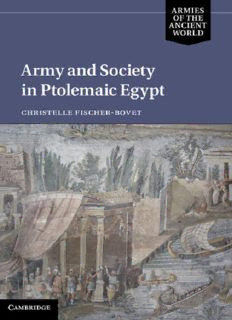
Army and Society in Ptolemaic Egypt PDF
Preview Army and Society in Ptolemaic Egypt
ArmyandSocietyinPtolemaicEgypt Thisistheonlysubstantialandup-to-datereferenceworkonthePtole- maic army. Employing Greek and Egyptian papyri and inscriptions, and building on approaches developed in state-formation theory, it offersacoherentaccountofhowthechangingstructuresofthearmy in Egypt after Alexander’s conquest led to the development of an ethnicallymoreintegratedsociety.AnewtripartitedivisionofPtole- maichistorychallengestheideaofgradualdeclineandemphasizesthe reshaping of military structures that took place between c. 220 and c.160BCinresponsetochangesinthenatureofwarfare,tomobiliza- tionanddemobilization,andtofinancialconstraints.Aninvestigation ofthesocio-economicroleplayedbysoldierspermitsareassessment ofthecleruchicsystemandshowshowsoldiers’associationsgenerated inter-ethnicgroupsolidarity.ByintegratingEgyptianevidence,Chris- telleFischer-Bovetalsodemonstratesthattheconnectionbetweenthe armyandlocaltemplesofferednewwaysforGreeksandEgyptiansto interact. christelle fischer-bovetisAssistantProfessorofClassicsat theUniversityofSouthernCalifornia. ArmiesoftheAncientWorld general editor: NicholasSekunda InstytutArchaeologiiUniwersytetuGdan´skiego titles in the series: ArmyandSocietyinPtolemaicEgypt ChristelleFischer-Bovet Army and Society in Ptolemaic Egypt christelle fischer-bovet UniversityPrintingHouse,CambridgeCB28BS,UnitedKingdom PublishedintheUnitedStatesofAmericabyCambridgeUniversityPress,NewYork CambridgeUniversityPressispartoftheUniversityofCambridge. ItfurtherstheUniversity’smissionbydisseminatingknowledgeinthepursuitof education,learningandresearchatthehighestinternationallevelsofexcellence. www.cambridge.org Informationonthistitle:www.cambridge.org/9781107007758 (cid:2)C ChristelleFischer-Bovet2014 Thispublicationisincopyright.Subjecttostatutoryexception andtotheprovisionsofrelevantcollectivelicensingagreements, noreproductionofanypartmaytakeplacewithoutthewritten permissionofCambridgeUniversityPress. Firstpublished2014 PrintedintheUnitedKingdombyClays,StIvesplc AcataloguerecordforthispublicationisavailablefromtheBritishLibrary LibraryofCongressCataloguinginPublicationdata Fischer-Bovet,Christelle,1977– ArmyandsocietyinPtolemaicEgypt/ChristelleFischer-Bovet. pages cm.–(Armiesoftheancientworld) Includesbibliographicalreferencesandindex. ISBN978-1-107-00775-8(hardback) 1.Ptolemaicdynasty,305B.C.–30B.C. 2.Egypt.Jaysh–History–To1500. 3.Armies–Egypt–History–To1500. 4.Sociology,Military–Egypt– History–To1500 5.Egypt–History,Military–To1500. 6.Egypt– History–332-30B.C. I.Title. DT92.F58 2014 355.00932(cid:3)09014–dc23 2013047248 ISBN978-1-107-00775-8Hardback CambridgeUniversityPresshasnoresponsibilityforthepersistenceoraccuracyof URLsforexternalorthird-partyinternetwebsitesreferredtointhispublication, anddoesnotguaranteethatanycontentonsuchwebsitesis,orwillremain, accurateorappropriate. Tomymotherandtothememoryofmyfather Contents Listoffigures [pagexi] Listofmaps [xiii] Listoftables [xiv] Listoftexts [xvi] Preface [xvii] Notesonabbreviations [xix] Maps [xxi] 1 Introduction [1] 1.1 AsocialandmilitaryhistoryofthePtolemaicstate [1] 1.2 PreviousviewsofPtolemaicEgyptandthearmy [4] 1.3 Anewapproach [7] 1.4 Methodology,sourcesandoutline [11] 2 ThearmyinLateperiodEgypt(664–332BC) [15] 2.1 Briefhistoricalsurvey [15] 2.2 MercenaryserviceinEgyptfromthereignofPsamtekI [18] 2.2.1 Lengthofsoldiers’staysandwavesofimmigration [19] 2.2.2 Militaryequipment [20] 2.2.3 Roleofmercenaries [22] 2.2.3.1 ThecivilwarbetweenApriesandAmasis [22] 2.2.3.2 MercenaryservicefromCambysestothesecond Persianoccupation [23] 2.2.4 Provenanceanddistribution [27] 2.2.4.1 EpigraphicevidenceforGreeksinEgypt [28] 2.2.4.2 MainGreeksettlements [31] 2.2.4.3 Carians [34] 2.2.4.4 AJewishgarrisoninElephantine [36] 2.2.4.5 Cypriots [37] 2.3 Egyptiansoldiersandtheorganizationofthearmy [37] part i structure and role of the army [45] 3 MilitarychallengesfacedbythePtolemies:power,money,crisis andreform [49] 3.1 Surveyofmilitaryevents,partI(331–221BC):armynumbers andcost [52] 3.1.1 FromAlexandertoPtolemyI:buildingaPtolemaicarmy [52] vii viii Contents 3.1.2 PtolemyII(285–246BC):thechallengeofathalassocracy [55] 3.1.3 PtolemyIII(246–221BC):theclimaxoftheempire [64] 3.1.4 Thecostofanempire:financinglandarmyandfleets [66] 3.1.4.1 Taxrevenuesandbooty [67] 3.1.4.2 Costofthenavy [71] 3.1.4.3 Costofthelandarmy [73] 3.1.4.4 ComparisonwiththeSeleucidempire:preludetothe FourthSyrianWar [75] 3.1.4.5 Generalassessmentofmilitaryactivityunderthefirst threePtolemies [83] 3.2 Surveyofmilitaryevents,partII(221–31BC):fromRaphiato Cleopatra [86] 3.2.1 PtolemyIVandPtolemyV:crisisleadingtoreform [86] 3.2.1.1 TheFourthSyrianWarandtheBattleofRaphia [86] 3.2.1.2 TheGreatRevolt(206–186BC) [92] 3.2.1.3 TheroleofsoldiersintheAlexandrianmobriots [94] 3.2.1.4 TheconsequencesoftheFifthSyrianWar (202–195BC)andoftheGreatRevolt [96] 3.2.2 Anewera:weaknessesandstrengthsunderPtolemyVIand PtolemyVIII(180–116BC) [98] 3.2.3 ThelastcenturyofPtolemaicrule(116–30BC) [105] 3.2.4 Contrastbetweenthethirdcenturyandthesecondandfirst centuriesBC [114] 4 Militaryorganizationandhierarchy [116] 4.1 Remunerationinwagesandinland:mercenaries(misthophoroi), cleruchsandmisthophoroikl¯erouchoi [118] 4.2 Militaryorganizationandreforms [123] 4.2.1 Cavalryunitsandequipment [125] 4.2.2 Cavalryreforms(c.220–c.160BC) [132] 4.2.3 Infantryunitsandequipment [133] 4.2.4 Infantryreforms:fromRaphia(217BC)tothe160sBC [142] 4.2.5 Elitetroops:cavalryoftheguard,royalguardandag¯ema [148] 4.2.6 Elephants [153] 4.3 Militaryhierarchy [155] 4.3.1 H¯egemones(officers)andhipparchai(cavalryofficers) [155] 4.3.2 Strat¯egoi(generals) [156] 4.3.3 Theeponymousofficers [158] 5 Militaryrecruitmentandethniccomposition [160] 5.1 EgyptiansinthePtolemaicarmyandpolice [161] 5.2 Macedonian,Greekandothersoldiers [166] 5.2.1 Recruitment [166] 5.2.2 Numbersandorigin [169] 5.2.3 Ethnicandpseudo-ethnicdesignationsinthearmy [177] 5.2.3.1 Persai,Persait¯esepigon¯es,Epigonoiand Makedones [178] 5.2.3.2 Otherregionalethnics [191]
Description: